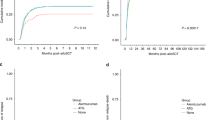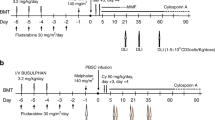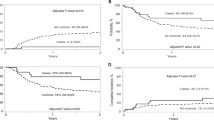Abstract
Rapid recovery of lymphocytes after T-cell depleted hematopoietic SCT (HSCT) protects from relapse of myeloid malignancies. Whether lymphocyte reconstitution has a similar role after non-manipulated transplantation is controversial. We assessed numbers of CD4 and CD8 T-cells, natural killer (NK) cells and B-cells, before and 1, 3, 6, 12 and 24 months after T-cell replete transplantation in 345 patients. Lymphocyte subset counts up to 6 months post transplant had no effect on relapse. Elevated number of NK cells 12 months post transplant protected from relapse. As a novel finding, early recovery of NK cells was associated with significant protection from TRM already at the 3 and 6 months time points (P=0.03, P=0.02). In Cox multivariable models, patients with NK cells above 150/μL were significantly protected from TRM (hazard ratio (HR) 0.45, 95% confidence interval (95% CI) 0.21–0.95, P=0.03), an effect comparable in magnitude with that of carrying >200 CD4 T-cells/μL (HR 0.37, 95% CI 0.19–0.74, P=0.005). CD8 T-cell and B-cell recovery did not affect the rates of relapse or TRM. Early reconstitution of NK cells and CD4 T-cells in patients undergoing T-cell replete HSCT independently protected from TRM. Only a weak protection from disease relapse was noted for patients with high numbers of NK cells, and this occurred only late after transplantation.
This is a preview of subscription content, access via your institution
Access options
Subscribe to this journal
Receive 12 print issues and online access
$259.00 per year
only $21.58 per issue
Buy this article
- Purchase on Springer Link
- Instant access to full article PDF
Prices may be subject to local taxes which are calculated during checkout


Similar content being viewed by others
References
Savani BN, Mielke S, Rezvani K, Montero A, Yong AS, Wish L et al. Absolute lymphocyte count on day 30 is a surrogate for robust hematopoietic recovery and strongly predicts outcome after T cell-depleted allogeneic stem cell transplantation. Biol Blood Marrow Transplant 2007; 13: 1216–1223.
Powles R, Singhal S, Treleaven J, Kulkarni S, Horton C, Mehta J . Identification of patients who may benefit from prophylactic immunotherapy after bone marrow transplantation for acute myeloid leukemia on the basis of lymphocyte recovery early after transplantation. Blood 1998; 91: 3481–3486.
Kim DH, Kim JG, Sohn SK, Sung WJ, Suh JS, Lee KS et al. Clinical impact of early absolute lymphocyte count after allogeneic stem cell transplantation. Br J Haematol 2004; 125: 217–224.
Le Blanc K, Barrett AJ, Schaffer M, Hagglund H, Ljungman P, Ringden O et al. Lymphocyte recovery is a major determinant of outcome after matched unrelated myeloablative transplantation for myelogenous malignancies. Biol Blood Marrow Transplant 2009; 15: 1108–1115.
Chang YJ, Zhao XY, Huo MR, Xu LP, Liu DH, Liu KY et al. Influence of lymphocyte recovery on outcome of haploidentical transplantation for hematologic malignancies. Medicine (Baltimore) 2009; 88: 322–330.
Chakrabarti S, Brown J, Guttridge M, Pamphilon DH, Lankester A, Marks DI . Early lymphocyte recovery is an important determinant of outcome following allogeneic transplantation with CD34+ selected graft and limited T-cell addback. Bone Marrow Transplant 2003; 32: 23–30.
Savani BN, Mielke S, Adams S, Uribe M, Rezvani K, Yong AS et al. Rapid natural killer cell recovery determines outcome after T-cell-depleted HLA-identical stem cell transplantation in patients with myeloid leukemias but not with acute lymphoblastic leukemia. Leukemia 2007; 21: 2145–2152.
Kumar S, Chen MG, Gastineau DA, Gertz MA, Inwards DJ, Lacy MQ et al. Effect of slow lymphocyte recovery and type of graft-versus-host disease prophylaxis on relapse after allogeneic bone marrow transplantation for acute myelogenous leukemia. Bone Marrow Transplant 2001; 28: 951–956.
Matthews K, Lim Z, Pearce L, Pagliuca A, Alejandro Madrigal J, Mufti GJ et al. Rapid recovery of lymphocyte subsets is not associated with protection from relapse of myelodysplastic syndromes and acute myeloid leukaemia after haematopoietic stem cell transplantation using a reduced intensity conditioning regimen and alemtuzumab. Br J Haematol 2010; 149: 879–889.
Lambert C, Cristina I, Christian G . Enumeration of peripheral lymphocyte subsets using 6 vs. 4 color staining: a clinical evaluation of a new flowcytometer. Cytometry B Clin Cytom 2006; 70: 29–38.
Kim DH, Sohn SK, Won DI, Lee NY, Suh JS, Lee KB . Rapid helper T-cell recovery above 200 × 10 6/l at 3 months correlates to successful transplant outcomes after allogeneic stem cell transplantation. Bone Marrow Transplant 2006; 37: 1119–1128.
Ruggeri L, Capanni M, Mancusi A, Urbani E, Perruccio K, Burchielli E et al. Alloreactive natural killer cells in mismatched hematopoietic stem cell transplantation. Blood Cells Mol Dis 2004; 33: 216–221.
Ruggeri L, Capanni M, Urbani E, Perruccio K, Shlomchik WD, Tosti A et al. Effectiveness of donor natural killer cell alloreactivity in mismatched hematopoietic transplants. Science 2002; 295: 2097–2100.
Wang H, Grzywacz B, Sukovich D, McCullar V, Cao Q, Lee AB et al. The unexpected effect of cyclosporin A on CD56+CD16- and CD56+CD16+ natural killer cell subpopulations. Blood 2007; 110: 1530–1539.
Berger M, Figari O, Bruno B, Raiola A, Dominietto A, Fiorone M et al. Lymphocyte subsets recovery following allogeneic bone marrow transplantation (BMT): CD4+ cell count and transplant-related mortality. Bone Marrow Transplant 2008; 41: 55–62.
Acknowledgements
MS was supported by the Swiss National Science foundation (grant PP00P3_128461/1).
Author information
Authors and Affiliations
Corresponding author
Ethics declarations
Competing interests
The authors declare no conflict of interest.
Rights and permissions
About this article
Cite this article
Bühlmann, L., Buser, A., Cantoni, N. et al. Lymphocyte subset recovery and outcome after T-cell replete allogeneic hematopoietic SCT. Bone Marrow Transplant 46, 1357–1362 (2011). https://doi.org/10.1038/bmt.2010.306
Received:
Revised:
Accepted:
Published:
Issue Date:
DOI: https://doi.org/10.1038/bmt.2010.306
Keywords
This article is cited by
-
Lymphoid and myeloid immune cell reconstitution after nicotinamide-expanded cord blood transplantation
Bone Marrow Transplantation (2021)
-
Increased bone marrow CD56bright natural killer cells at 30 days after allogeneic stem cell transplantation associated with adverse patient outcome
Bone Marrow Transplantation (2019)
-
Beneficial role of CD8+ T-cell reconstitution after HLA-haploidentical stem cell transplantation for high-risk acute leukaemias: results from a clinico-biological EBMT registry study mostly in the T-cell-depleted setting
Bone Marrow Transplantation (2019)
-
Comparison of reference values for immune recovery between event-free patients receiving haploidentical allografts and those receiving human leukocyte antigen-matched sibling donor allografts
Frontiers of Medicine (2018)
-
Low incidence of severe cGvHD and late NRM in a phase II trial of thymoglobulin, tacrolimus and sirolimus for GvHD prevention
Bone Marrow Transplantation (2017)



